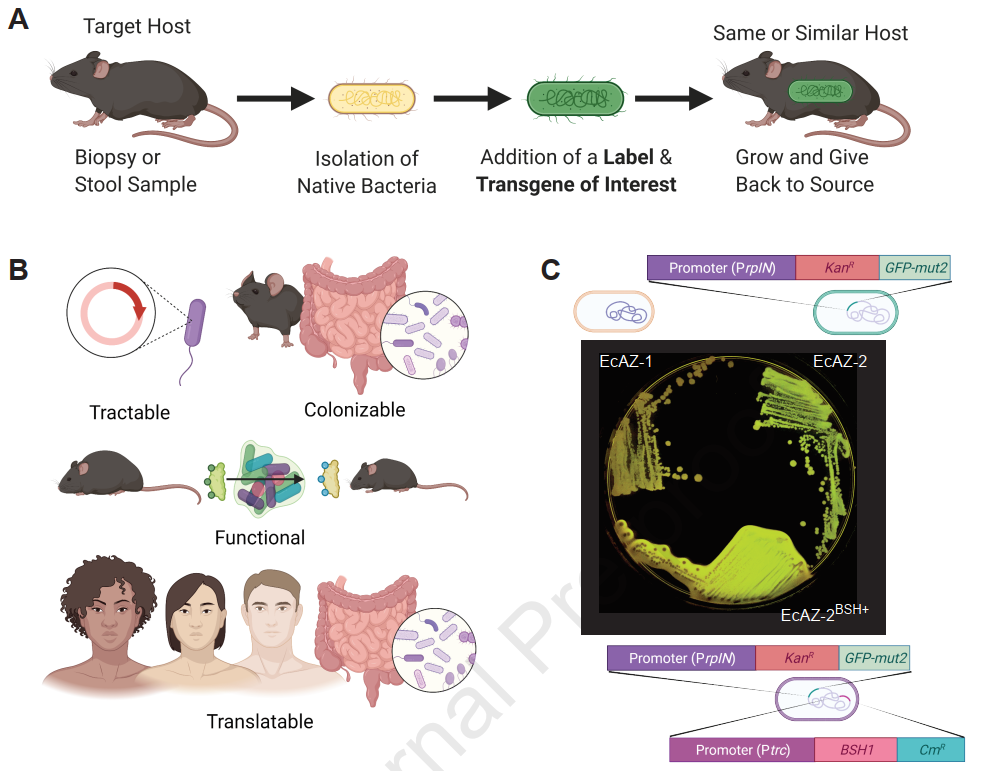breakthrough!Natural E. coli as a "chassis" implantation host can cause changes in lasting and stable function
Author:Bioart biological art Time:2022.08.16

Written article | qi
##
Live Bacterial Therapeutics (LBT) can reverse the disease by implanting the intestine and providing lasting beneficial functions in the host, especially chronic diseases including obesity, type 2 diabetes, non -alcoholic fatty liver and other chronic diseases. It can also be designed to express the function of solving the congenital metabolic errors (such as phenylalanine metabolism in patients with phenyloneuria) [1]. A key step of engineering LBT is to choose a microorganism chassis to perceive the environment, regulate gene expression and production and treatment products. However, the current LBT chassis (such as E. coli NISSLE 1917, Peribrium, and Clason Clasa) cannot be transplanted and survived in the intestinal environment. It is difficult to locate to specific areas such as proximal intestines, so function transmission is not reliable [2] Essence Therefore, proper chassis selection is still a major obstacle to transforming synthetic biology into human diseases.
LBT's survival in the lumen environment is facing many challenges, including the host (such as peristalsis, congenital and adaptive immunity) and other natural microorganisms (such as competition and ecological availability). Theoretically, "Aboriginal" microorganisms have maximized the host of the host intestinal cavity, bypassing almost all implantation disorders, making it an ideal chassis for genetically modified transmission, but they are difficult to cultivate and modify.
On August 4, 2022, the Amir ZarrinPar team from the University of California, San Diego, published a article entitled Intestinal Transage Delivery with Native E. Coli Chassis Persisiology Changes in CELL Magazine. The separated natural E.neer is modified to express functional genes, and re -introduction of these strains will stabilize them in the intestine and continue to express. This engineering E. coli can induce changes in the functional changes that affect the physiological and reversal pathology of hosts after several months of administration. Therefore, the chassis of the use of indigenous bacteria as a specific function of "knocking into" can be studied for specific microorganisms in the host, and LBT with the treatment purpose can be achieved.

In this study, the author uses a natural E. coli ECAZ-1, a CR-WT C57BL/6 male mouse feces from the Bar Harbor (ME), which is separated from the phage The guide will be introduced to ECAZ-1 related to Kenamycin resistance to generate tracking bacteria ECAZ-2. The engineering transformation was then generated to generate two different engineering bacteria: ECAZ-2 BSH+(bile saline enzyme) and ECAZ-2 IL10+. Next, the author performs stomachs among the C57BL/6 mice that are not treated with antibiotics to evaluate the ability of the candidate chassis to stabilize the intestinal tract of mice. ECAZ-2 stabilizes the planting in all mice for more than 110 days. Subsequently, the author cultivated the gastrointestinal tract to determine the degree of bacterial planting in each area of the intestine. Compared with the reported engineering non-natural E. coli, ECAZ-2 was planted in the proximal intestine/small intestine. The highest planting in the intestine, while the IL-10 strains are the highest in the enlargement and empty intestine. In addition, BSH and IL-10 can be detected from the bacterial separators obtained by two mice, indicating that the ECAZ-2 can be planted in the host for long-term stability and continuously, while retaining the genetic function.

Figure 1. Intestinal natural E. coli is easily treated in genes and can be used as a chassis transmitted by genetically modified.
It proves that the native bacteria is inherited in genetic and can be continuously planted in the proximal intestine and colon, and the author uses BSH strains as an example to further evaluate whether the genetically modified transmitted genetically transmitted by the ECAZ-2 chassis can manipulate the main intestinal environment. Studies have shown that the changes in bile acids caused by BSH activity will affect a variety of metabolic systems, including glucose, lipids and bile acid stability, and immune/inflammation and heat production [3]. The increased BSH activity will affect all these different bile Acid pool. The author found that compared with mice planted with ECAZ-2, mice with ECAZ-2 BSH+planted have a significant and higher level of maternal stool bile acid. In addition, compared with the mice treated with ECAZ-2, the ECAZ-2 BSH+mice with the stomach reduces primary feces bile acid and primary bile acid. So will the changes in bile acid in the tubular cavity cause the overall changes of the intestinal microbial group? The analysis of the microbial group shows that there is no detection difference in any microbiome group measurement. Therefore, although the changes in the metabolic group in the cavity are induced, the engineering natural bacteria did not induce the composition of the intestinal microbial group.
Next, the author wants to know whether the ECAZ-2 BSH+planting will affect the physiology of the host, so the impact of these differences in cyclic bile acid on the genetic expression on the liver, focusing on the genetic genes that are important for bile acid metabolism. The results showed that the expression of FXR, SHP, and CYP27A1 increased, which is consistent with the synthesis of bile acid biological in the replacement approach. It may be to reduce the high excretion of bile acids in mice planted in ECAZ2 BSH+. This shows that adding a single gene to a natural bacteria to the microbiome group can significantly change the physiology of the host. In order to determine whether the genetically transmitted by the natural E. coli chassis can be used to improve the disease, the author has studied the role of ECAZ-2 BSH+ in type 2 diabetic genetic model OB/OB mice. Although the weight is the same, after receiving the single treatment of natural bacteria more than 3 months ago, compared with the control group, the insulin sensitivity of ECAZ-2 BSH+OB/OB mice has improved significantly. Therefore, these experiments show that the use of natural E. coli for genetically modified delivery will affect the serum metabolic group, the outside of the intestine (such as the liver) gene expression, the host physiology, and improve the disease several months after a single administration. Finally, in order to determine whether the engineering natural bacterial strategy can be converted into humans, the author is separated from the E. coli strains in multiple regions of the gastrointestinal tract of the volunteer inspection of the conventional outpatient endoscopy. The antibiotic sensitivity of the strain, the easy treatment of the guide, etc. Despite genetic easily, further research still needs to determine whether the autologous metastasis of natural bacteria can lead to the long -term planting and long -term chronic diseases and genetic diseases of human host.
In short, this work shows a simple technology that can be completed by almost any laboratory to improve the ability to use engineering bacteria to effectively change the physiological function of the host. By combining the technology with the natural strain, the E. coli from the host can be used as a chassis, and the specific function is knocked into the intestinal microbial group. , Continuous metabolic changes, etc. If the engineering natural bacterial strategy is successfully developed and transformed into human beings, it may introduce new therapeutic biological treatment drugs to improve the treatment of chronic disease without relying on patient compliance.

Original link:
https://www.cell.com/cell/fulltext/s0092-8674 (2-2)00843-1
references
1. Puurunen, m.k, vockley, j., searle, s.L., Sacharow, S.J., Phillips, J.A., 3rd, Denney, W.S., B.D., Wagner, D.A., Blankstein, L., Castillo, ET AL. 2021). Safety and Pharmacodynamics of An Engineered E. Coli Nissle for the Treatment of Phenylketonuria: A FIRST-in-Human Phase 1/2A Study. Nat Metab 3, 1125-1138/S42538/S422538/S422538/S422538/S422538/S422538/S422538/S42538/S42538/S42538/S42538253/S4238/S42/S42/S42/S42/Snat that Pifa that
2. Pedrolli, D.B., Ribeiro, N.V., Squizato, P.N., de Jesus, V.N., Cozetto, D.A., and Team, A.Q.A.U.a.i. (2019). Engineering Microbial Living Therapeutics: The Synthetic Biology Toolbox. Trends in biotechnology 37, 100-115. 10.1016/j.tibtech.2018.09.005.
3. Wahlstrom, A., Sayin, S.I., Marschall, H.U., and Backhed, F. (2016). Intestinal Crosstalk between Bile Acids and Microbiota and Its Impact on Host Metabolism. Cell metabolism 24, 41-50. 10.1016/j. CMET.2016.05.005.
Want to know more exciting content, come and pay attention to BIOART biological art


- END -
From Ruian Welfare Institute to Shandong, at the age of 42, she was looking for Ryan's loved ones

After living in Shandong for 42 years, Xiao Ling finally decided to find Ryan's re...
[Health and Health] "Nourishing the back is to raise the whole body"!Seven are the most afraid of the back, don't do it again

Content sorting out WeChat from Life Times, China Traditional Chinese Medicine Dai...